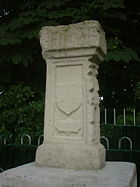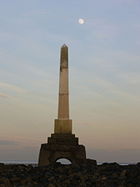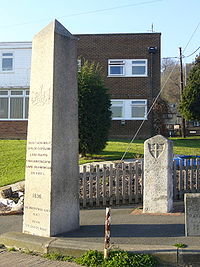.gif)
London Stone (riparian)
Encyclopedia
London Stone is the name given to a number of boundary stones
which stand beside rivers in south east England
.
held the right to fish the rivers of England and charged duties
on those people it licenced to fish. In 1197 King Richard I
, in need of money to finance his involvement in the Third Crusade
, sold the rights over the lower reaches of the River Thames
to the City of London
. Marker stones were erected to indicate the limit of the City's rights.
In Victorian
times, the Lord Mayor would come in procession by water and touch the Staines stone with a sword to re-affirm the City's rights.
Control of the river passed in turn from the City to the Thames Conservancy
, the Port of London Authority
(below Teddington) and finally to the Environment Agency
.


 In medieval times before the canalisation of the Thames, Staines
In medieval times before the canalisation of the Thames, Staines
was the highest point to which tides reached. It was also the next bridge upstream from London Bridge
, a distance of 31 km as the crow flies
. The London Stone here marked the upstream limit of the City's rights. It was originally erected in 1285 near Staines Bridge following the grant of a charter by Edward I
. The original location is confirmed by the semi-circular indentations (on the right hand face in the photo). These were created by the tow ropes of horse-drawn boats rubbing against the stone.
In 1750 (approx.) the stone was moved about 500 metres upstream to a site at on the north bank of the river in the Lammas Pleasure Ground. Later the stone was moved to the Old Town Hall Arts Centre, Market Square, Staines and a replica was placed in the Pleasure Ground. It is now in the museum attached to Staines Library.
The stone proper is only about 60 cm high. Any inscription it may once have had has worn away. It stands on a plinth inscribed with the names of various City worthies who may have been involved in its 1750 move, all of which is now a Grade II listed structure. Martin Nail included the Stone as No. 83 in his list of Coal and Wine Tax Posts since it happens to stand on the line of route of the posts.
.
The overall height of the monument is about 8 metres. The main column has an inscription, now illegible. The plinth on which it stands has an inscription listing various worthy gentlemen who were probably involved in the re-erection of the stone in Victorian times. They include Horatio Thomas Austin
and Warren Stormes Hale
, sometime Lord Mayor and founder of the City of London School
.
(two nearby roads are called Crowstone Avenue and Crowstone Road). It was erected in 1837 and replaced a smaller stone, dating from 1755. The older stone was removed to Priory Park in Southend where it remains today. It is likely that there has been a marker on this site and at Yantlet since 1285.
The line between the Crow Stone and the London Stone, Yantlet Creek is known as the 'Yantlet Line and is used as the boundary for various things including the limit of jurisdiction of the Port of London Authority
.
Venture Centre and the River Medway
in Lower Upnor
. The older, smaller stone is dated 1204 and carries on its rear the inscription "God preserve the City of London". Apart from that the inscriptions of both stones are merely the names of various Lord Mayors and years.
Boundary marker
A boundary marker, boundary stone or border stone is a robust physical marker that identifies the start of a land boundary or the change in a boundary, especially a change in a direction of a boundary...
which stand beside rivers in south east England
England
England is a country that is part of the United Kingdom. It shares land borders with Scotland to the north and Wales to the west; the Irish Sea is to the north west, the Celtic Sea to the south west, with the North Sea to the east and the English Channel to the south separating it from continental...
.
History
Until 1350, the English CrownThe Crown
The Crown is a corporation sole that in the Commonwealth realms and any provincial or state sub-divisions thereof represents the legal embodiment of governance, whether executive, legislative, or judicial...
held the right to fish the rivers of England and charged duties
Duty (economics)
In economics, a duty is a kind of tax, often associated with customs, a payment due to the revenue of a state, levied by force of law. It is a tax on certain items purchased abroad...
on those people it licenced to fish. In 1197 King Richard I
Richard I of England
Richard I was King of England from 6 July 1189 until his death. He also ruled as Duke of Normandy, Duke of Aquitaine, Duke of Gascony, Lord of Cyprus, Count of Anjou, Count of Maine, Count of Nantes, and Overlord of Brittany at various times during the same period...
, in need of money to finance his involvement in the Third Crusade
Third Crusade
The Third Crusade , also known as the Kings' Crusade, was an attempt by European leaders to reconquer the Holy Land from Saladin...
, sold the rights over the lower reaches of the River Thames
River Thames
The River Thames flows through southern England. It is the longest river entirely in England and the second longest in the United Kingdom. While it is best known because its lower reaches flow through central London, the river flows alongside several other towns and cities, including Oxford,...
to the City of London
City of London
The City of London is a small area within Greater London, England. It is the historic core of London around which the modern conurbation grew and has held city status since time immemorial. The City’s boundaries have remained almost unchanged since the Middle Ages, and it is now only a tiny part of...
. Marker stones were erected to indicate the limit of the City's rights.
In Victorian
Victorian era
The Victorian era of British history was the period of Queen Victoria's reign from 20 June 1837 until her death on 22 January 1901. It was a long period of peace, prosperity, refined sensibilities and national self-confidence...
times, the Lord Mayor would come in procession by water and touch the Staines stone with a sword to re-affirm the City's rights.
Control of the river passed in turn from the City to the Thames Conservancy
Thames Conservancy
The Thames Conservancy was a historical body responsible for the management of the River Thames in England. It was founded in 1857, initially replacing the jurisdiction of the City of London up to Staines and later taking responsibility for the whole river from Cricklade in Wiltshire to the sea at...
, the Port of London Authority
Port of London Authority
The Port of London Authority is a self-funding public trust established in 1908 by the Port of London Act to govern the Port of London. Its responsibility extends over the Tideway of the River Thames and the authority is responsible for the public right of navigation and for conservancy of the...
(below Teddington) and finally to the Environment Agency
Environment Agency
The Environment Agency is a British non-departmental public body of the Department for Environment, Food and Rural Affairs and an Assembly Government Sponsored Body of the Welsh Assembly Government that serves England and Wales.-Purpose:...
.
Staines



Staines
Staines is a Thames-side town in the Spelthorne borough of Surrey and Greater London Urban Area, as well as the London Commuter Belt of South East England. It is a suburban development within the western bounds of the M25 motorway and located 17 miles west south-west of Charing Cross in...
was the highest point to which tides reached. It was also the next bridge upstream from London Bridge
London Bridge
London Bridge is a bridge over the River Thames, connecting the City of London and Southwark, in central London. Situated between Cannon Street Railway Bridge and Tower Bridge, it forms the western end of the Pool of London...
, a distance of 31 km as the crow flies
As the crow flies
"As the crow flies" or beelining is an idiom for the shortest route between two points; the geodesic distance.An example is the great-circle distance between Key West and Pensacola, at either end of the U.S...
. The London Stone here marked the upstream limit of the City's rights. It was originally erected in 1285 near Staines Bridge following the grant of a charter by Edward I
Edward I of England
Edward I , also known as Edward Longshanks and the Hammer of the Scots, was King of England from 1272 to 1307. The first son of Henry III, Edward was involved early in the political intrigues of his father's reign, which included an outright rebellion by the English barons...
. The original location is confirmed by the semi-circular indentations (on the right hand face in the photo). These were created by the tow ropes of horse-drawn boats rubbing against the stone.
In 1750 (approx.) the stone was moved about 500 metres upstream to a site at on the north bank of the river in the Lammas Pleasure Ground. Later the stone was moved to the Old Town Hall Arts Centre, Market Square, Staines and a replica was placed in the Pleasure Ground. It is now in the museum attached to Staines Library.
The stone proper is only about 60 cm high. Any inscription it may once have had has worn away. It stands on a plinth inscribed with the names of various City worthies who may have been involved in its 1750 move, all of which is now a Grade II listed structure. Martin Nail included the Stone as No. 83 in his list of Coal and Wine Tax Posts since it happens to stand on the line of route of the posts.
Yantlet Creek
The downstream limit of the City's rights is about 54 km as the crow flies from London Bridge and is marked on both banks of the river. On the south bank the marker is the London Stone which stands at beside the mouth of Yantlet Creek on the Isle of GrainIsle of Grain
The Isle of Grain, in the north of Kent, England, is the easternmost point of the Hoo Peninsula. No longer an island, the Isle is almost all marshland and the Grain Marshes are an important habitat for birdlife...
.
The overall height of the monument is about 8 metres. The main column has an inscription, now illegible. The plinth on which it stands has an inscription listing various worthy gentlemen who were probably involved in the re-erection of the stone in Victorian times. They include Horatio Thomas Austin
Horatio Thomas Austin
Sir Horatio Thomas Austin was a British officer in the Royal Navy, and an explorer of the Canadian arctic. Following the 1849 failure of James Clark Ross's attempt to locate the lost Franklin Expedition, Austin led an 1850 expedition that also attempted to find Sir John Franklin and his crew....
and Warren Stormes Hale
Warren Stormes Hale
Warren Stormes Hale was Lord Mayor of London and founder of the City of London School.Born on 2 February 1791 he was orphaned and became an apprentice candlemaker or chandler; he was later twice Master of the Tallow Chandlers' Company....
, sometime Lord Mayor and founder of the City of London School
City of London School
The City of London School is a boys' independent day school on the banks of the River Thames in the City of London, England. It is the brother school of the City of London School for Girls and the co-educational City of London Freemen's School...
.
Crow Stone
The marker on the north bank is almost due north of Yantlet Creek and is called the Crow Stone (also known as Crowstone or City Stone). It stands at on the mud opposite the end of Chalkwell Avenue, Southend-on-SeaSouthend-on-Sea
Southend-on-Sea is a unitary authority area, town, and seaside resort in Essex, England. The district has Borough status, and comprises the towns of Chalkwell, Eastwood, Leigh-on-Sea, North Shoebury, Prittlewell, Shoeburyness, Southchurch, Thorpe Bay, and Westcliff-on-Sea. The district is situated...
(two nearby roads are called Crowstone Avenue and Crowstone Road). It was erected in 1837 and replaced a smaller stone, dating from 1755. The older stone was removed to Priory Park in Southend where it remains today. It is likely that there has been a marker on this site and at Yantlet since 1285.
The line between the Crow Stone and the London Stone, Yantlet Creek is known as the 'Yantlet Line and is used as the boundary for various things including the limit of jurisdiction of the Port of London Authority
Port of London Authority
The Port of London Authority is a self-funding public trust established in 1908 by the Port of London Act to govern the Port of London. Its responsibility extends over the Tideway of the River Thames and the authority is responsible for the public right of navigation and for conservancy of the...
.
Upnor
Two London Stones stand at between the ArethusaArethusa
- Mythology :* Arethusa , a nereid nymph who became a fountain* See Hesperides for Arethusa, a hesperid nymph- Places :* Arethusa , an ancient city in Mygdonia of ancient Macedonia* Arethusa , a titular see of Syria near Apameia...
Venture Centre and the River Medway
River Medway
The River Medway, which is almost entirely in Kent, England, flows for from just inside the West Sussex border to the point where it enters the Thames Estuary....
in Lower Upnor
Upnor
Lower Upnor and Upper Upnor are two small villages in Medway, Kent, England. They are in the parish of Frindsbury Extra on the western bank of the River Medway...
. The older, smaller stone is dated 1204 and carries on its rear the inscription "God preserve the City of London". Apart from that the inscriptions of both stones are merely the names of various Lord Mayors and years.
External links
- Pages on geograph for: London Stone, Staines, the Crow Stone, London Stone, Yantlet Creek
- Google search for "Yantlet Line"
- The PLA page of thames.me.uk

